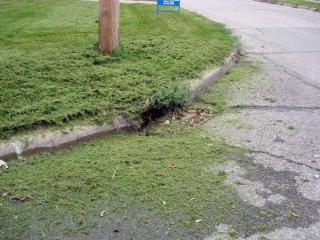Lawn & Garden Tips to Curb Stormwater Polution
Posted on: June 28, 2019 - 2:48pm

Lawn & Garden Tips to Reduce Stormwater Polution
The Impact
Nutrients and other chemicals from yard waste can cause excessive algae growth and toxin production. Algae can rob the organisms that live in our streams from the oxygen they need to survive, not to mention killing fish along the way, but You Can Make a Difference
Lawn Care
- Mow your lawn so no more than one-third of the length of the grass is removed, keep your grass at least 3-inches high.
- Leave the grass blades on the lawn or compost them.
- Compost or throw away leaves and other organic matter instead of putting it in the streets. Excess leaves and organic matter can contribute to nutrient levels in streams.
- The Transfer Station has a compost area, get a sticker and dispose of them there.
- Sweep grass on all paved areas back on the lawn.
- Hand pick or spot treat for weeds or not at all.
Watering
- Do not over water. Excessive runoff wastes both water and chemicals you may have added to your yard.
- Direct downspouts to a depressed area or a garden bed so the water soaks into your yard instead of rushing out to the street.
- Rain Barrels are a great way to store rainwater from downspouts.
Fertilizing
- Fertilize only when necessary or not at all. Have your soil tested before you apply so you know what nutrients you need for your yard.
- Umass Amherst Soil Testing Lab
- Do not fertilize if it the forecast calls for rain in the next day or two.
- Make sure to follow all fertilizer instructions and use only what you need. Too much fertilizer will can runoff your yard and into storm drains.
- Use compost whenever possible instead of fertilizer. Compost has many benefits such as providing sufficient nutrients for your landscape but also improving soil health.
Yard Design
- Consider installing a rain garden and directing your roof drains to it.
- Incorporate swales and berms to your landscape so runoff is contained and doesn’t leave your yard.
- Consider using bricks, flagstone, gravel, and other porous materials instead of impervious surfaces, such as sidewalks and driveways.
- Add trees and shrubs to capture and hold rainwater before it can reach the ground.
Irrigation Ditches and Creek Areas
- Keep a mowing and fertilizing buffer 2-3 feet wide around ditches and creeks so that erosion and nutrient loading are minimized.
Exterior Cleaning
- Use dry cleanup methods, such as a broom and dust pan whenever possible.
- If you must use water, divert it to landscaping where it can infiltrate.

